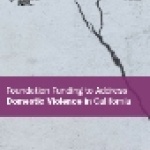Be the Solution

Last week I was honored to speak at an event hosted by our grantee, Center for the Pacific Asian Family (CPAF). That same week, the media — and our entire country — turned its attention to the issue of domestic violence. While we marked the 20th Anniversary of the passage of the Violence Against Women Act, we also became privy to the violent actions of former Baltimore Ravens running back Ray Rice against his wife Janay Palmer Rice. In addition to inciting criticism of the NFL’s policies, the incident has sparked important public dialogue around the topic of domestic violence.
For us, domestic violence has never been a private issue; but rather one that involves and affects nearly every facet of our communities. Greater public awareness and discussions are a step in the right direction. From here, we hope the conversation will grow into action.
This quarter, and every quarter since our re-launch in 2002, Foundation funds are dedicated to supporting domestic violence service providers across California. These essential agencies not only serve as first responders to violence through their hotlines, they also provide shelter, counseling services, and legal aid, and help to prevent future abuse through extensive community and school-based programs. Every day, these organizations are working to change the prevailing statistic that one in four women will experience domestic violence in her lifetime.
Unfortunately, they can’t do it alone. Everyone can, and should, be a part of the solution. While at CPAF, I outlined four things that others can do to get involved in the movement to end domestic violence. They are:
- Do not isolate your attention on this one incident — or those that only involve a famous athlete. In homes across the U.S. there are victims of domestic violence. The issue does not go away when the media does. There is always an opportunity to become an advocate or start volunteering in your community.
- In addition to supporting survivors, recognize and help prevent the long-term consequences of domestic violence. Children exposed to violence in their home will grow up and have worse health outcomes than those who do not carry the same burden. We must break the cycle of violence for future generations.
- Engage the healthcare system in the prevention, detection, and treatment of abuse. Under the Affordable Care Act, insured adults now have access to free DV screening and referral services. We must work to ensure that a comprehensive DV support system is in place in all of our hospitals and clinics.
- Finally, and most importantly, know that domestic violence is not someone else’s problem or responsibility. It is all of ours. No one should be bystander to violence. If you see something, say something.
In the midst of this tragedy, there is always a teachable moment. Whether it is giving your time, your talent, or your treasure, I urge all of you to get involved, because it will take effort from everyone to end domestic violence. It’s a big job, but it’s one worth doing.
How will you #BeTheSolution?
Get our newsletter
Sign up for occasional event announcements and our newsletter, Intersections, to learn more about the work we’re supporting to make California the healthiest state and end domestic violence.


